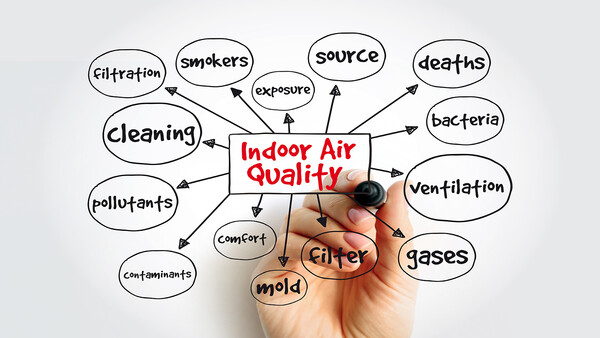How building automation impacts health, efficiency, and indoor air quality in hospitals
How does building automation ensure hospitals are safe, secure, comfortable environments for everyone?





During July 1943 a mysterious haze filled the air in Los Angeles, California. Reduced visibility resulted in automobile accidents. The yellow haze caused eye irritation. Wafting black dust collected on windowsills while triggering coughs and difficulty breathing. The now-infamous Los Angeles smog was merely a harbinger of things to come in population centers worldwide.
The risks of air pollution to health and welfare are well known. Contamination results from human behaviors such as carbon emissions, agriculture, construction, industrial exhaust, poor sanitation, and wildfires. Airborne dust particles, pollen spores, natural disasters, and global warming serve to exacerbate ambient air pollution. Even after half a century of clean air regulation, in 2018 Los Angeles experienced 87 days in a row of air quality that was unhealthy and in violation of federal standards (Guerin 2018; Bendix 2019). When the air outdoors is particularly unhealthy, authorities warn citizens to remain indoors. But the air outside is not the only threat.
At rest, the average adult inhales 7 to 8 liters of air per minute, or about 11,000 liters per day (Discovery Health n.d.). In the developed world, most people spend on average 90 percent of their time indoors where, according to the US Environmental Protection Agency (EPA), “the concentrations of some pollutants are often 2 to 5 times higher than typical outdoor concentrations” (US Environmental Protection Agency [EPA] 2018). Indoor air quality (IAQ) “has been identified by the EPA as one of the top five most urgent environmental risks to public health” (US Occupational Safety and Health Administration [OSHA] 2011). As with ambient air pollution, poor IAQ poses a significant threat to human health and welfare, comfort, productivity, and organizational efficacy. Some studies indicate that more people suffer from the adverse effects of indoor air pollution than outdoor.
The US Occupational Safety and Health Administration reports that health effects related to poor IAQ might be experienced acutely, soon after exposure, or chronically, years later. The symptoms can easily be mistaken for allergies, stress, colds, and influenza. They include “irritation of the eyes, nose, and throat; headaches; dizziness; rashes; and muscle pain and fatigue” (OSHA 2011). The American College of Allergy, Asthma and Immunology has found that nearly 50 percent of all respiratory illness are caused or worsened by sick building syndrome, a term used to describe acute health and comfort effects resulting from unhealthy conditions in the built environment, including poor IAQ (Kimberly-Clark Professional 2010). Despite the proven threats of harmful IAQ, the danger remains largely unacknowledged.
IAQ contaminants come from many sources. Facility occupants introduce carbon dioxide, artificial scents such as perfume, natural body odors, and tobacco smoke. Building materials contribute dust, fiberglass, asbestos, and volatile organic compounds (VOCs). VOCs are easily vaporized or emitted as gases from furniture, carpet, paint, and solvents, including cleaners, pesticides, disinfectants, and adhesives. Excessive humidity and moisture can result in microbial contaminants, mold, and bacteria. Copiers, electric motors, and electrostatic air cleaners create harmful ozone as a by-product of normal operation (Canadian Centre for Occupational Health and Safety [CCOHS] 2018).
Inadequate ventilation through the introduction of fresh outdoor air can be insufficient to dilute or displace indoor contaminants. Deficient filtration and poor mechanical maintenance, together with poorly designed temperature, humidity, and air quality control mechanisms, are common causes of unhealthy IAQ (CCOHS 2018).
A 2016 study of 94,000 workers in 14 major occupations revealed that absenteeism due to chronic health conditions results in lost productivity that costs US organizations nearly $84 billion annually (Folger 2019). A parallel study found that for every 10 workers, poor IAQ adds six sick days per year (Kimberly-Clark Professional 2010). The American Lung Association reports that asthma, which afflicts 6 percent of Americans, is the reason for 14.5 million missed workdays, while the US Centers for Disease Control and Prevention estimates that sinus infection sufferers miss an average of four workdays each year (Kimberly-Clark Professional 2010). Perhaps even more costly is presenteeism, or working when sick, with individual productivity losses of over 30 percent (Kimberly-Clark Professional 2010).
Poor IAQ is a problem not only in the workplace. A recent study of primary and secondary schools with new mechanical systems (installed within three years) performed by the University of California, Davis revealed that 85 percent of classrooms were under ventilated. A reporter in The Sacramento Bee commented, “If classrooms lack proper ventilation, students and teachers are exposed to unhealthy levels of carbon dioxide and air pollutants such as volatile organic compounds, including formaldehyde. While the VOCs are given off as gas from building materials, finishes and furniture, the ratio of CO2 rises as the students and teachers exhale it. Without new air coming into the building, there’s a build-up of indoor pollutants that not only can cause respiratory conditions such as asthma but also can impair cognitive performance” (Anderson 2019).
A 2013 study released by the Lawrence Berkeley National Laboratory at the US Department of Energy found that “elementary schools with poor ventilation rates reported an increased number of absences related to illnesses.” One of the researchers added, “We were able to find in that study that classrooms that were better ventilated tend to have lower illness absentee rates, and that’s very significant. As kids miss school more, they fall behind, and so it’s really associated with the learning of students” (Anderson 2019).
The UC Davis study indicates that poor IAQ is a particular risk because unlike thermal comfort, it’s difficult for occupants to perceive inadequate ventilation. Schools with IAQ monitoring and control, including basic CO2 sensors and demand-controlled ventilation, had improved ventilation performance. However, researchers added that mechanical and control systems were often poorly designed, deployed, and commissioned because “most new HVAC systems are installed in summer while staff and students are off from school…the focus often is on completing the project before everyone returns rather than on whether state standards are met” (Anderson 2019). A traditional process that prioritizes the lowest possible initial cost can preclude even low life-cycle cost solutions like IAQ sensors and monitoring with simple ventilation management.
Many solutions for poor IAQ are preventative and include good design practices in addition to proper operation and maintenance. However, often ignorance stands in the way. Theresa Pistochini, engineering manager at the UC Davis Western Cooling Efficiency Center, identified two common root causes. “The real challenge in dealing with this issue…is that there’s very little awareness of the issue. Many school personnel aren’t trained…and neither they nor the contractors are doing the state-mandated testing to determine whether ventilation standards are being met” (Anderson 2019). Reliable Controls Authorized Dealers are ideally positioned to provide the knowledge and expertise required to empower improving IAQ in commercial and institutional built portfolios. This expert judgment is complemented by the simple, flexible, and sustainable Reliable Controls hardware and software suite.
Too much fresh air can provide healthy IAQ but consume excessive fan and mechanical energy. Too little outdoor air and ventilation is positive for energy conservation but often contributory to poor IAQ. An optimized IAQ strategy involves leveraging the synergy between energy conservation and adequate ventilation. This goal is realized by providing the minimum required ventilation based on real-time conditions. Every Reliable Controls controller is freely programmable. This means that strategies to improve indoor health can be easily developed and deployed in any system, new or old, with minimal cost. Even existing systems not originally designed to monitor or manage IAQ can be easily optimized. As a tangible metric, IAQ must be measured to be managed.
Both the traditional and networked field devices in the SPACE-Sensor™ and SMART-Sensor™ series feature sensors to monitor IAQ, including occupancy, humidity, and CO2. New sensing options in all space sensors will further empower IAQ management. Measurement, while important, is only the first step. Pistochini says, “When a brand new HVAC system gets installed, if the heating or cooling isn’t working, you know that right away. The teachers can say, ‘It’s 90 degrees in here. Look at my thermostat. Something is not working. It isn’t working.’ But with ventilation, it’s very hard to perceive whether or not you’re getting enough outdoor air” (Anderson 2019). Not so with the MACH-ProView™. The integrated LCD complements the requisite IAQ sensors with occupancy awareness and engagement. The STATview and SPACEview optionally integrate IAQ metrics in the indoor environment experience. The TRENDview displays IAQ over time. ALARMview and alarm notifications annunciate poor IAQ to occupants and facility operations teams.
The Reliable Controls software suite, particularly the diverse and scalable operator interfaces in RC-WebView®, the MACH-ProWeb™, and myControl®, allows administrators, operations teams, occupants, and even stakeholders, like parents, to transparently monitor IAQ. RC-Archive® and RC-Reporter® deliver proof of performance and a record of improvement over time. Analysis of archived IAQ data can be used to prioritize equipment maintenance and replacement, allowing facility executives to make informed decisions. By providing insight at a glance and empowering informed decisions, a Reliable Controls building automation system can become a valuable business tool.
Even after thorough commissioning, performance of facilities and systems naturally degrades over time. Operations teams can achieve and maintain optimal real-time performance with the benefit of Reliable Controls Integrated Fault Detection and Diagnostics (IFDD). When operators can easily identify under-ventilated zones, filters that need to be replaced, and equipment that requires maintenance and take the steps necessary to restore optimal performance, the facility automation system can become a valuable component of the IAQ team.
According to the EPA, “Indoor concentrations of some pollutants have increased in recent decades due to such factors as energy-efficient building construction (when it lacks sufficient mechanical ventilation to ensure adequate air exchange) and increased use of synthetic building materials, furnishings, personal care products, pesticides, and household cleaners. People who are often most susceptible to the adverse effects of pollution (e.g., the very young, older adults, people with cardiovascular or respiratory disease) tend to spend even more time indoors” (US EPA 2018).
Controlling the indoor environment and empowering occupants with simple and insightful engagement is the business of Reliable Controls and Reliable Controls Authorized Dealers. How exciting and fulfilling it is to protect the people and property of the organizations with whom we partner, particularly those who are most sensitive and depend on the quality of their indoor environment. Helping people lead healthier, happier, and more productive lives while improving stewardship of our planet is why we’re in this business. Improving indoor air quality is just one more way we are people and technology you can rely on.
Anderson, Cathie.”How California schools’ HVAC systems are ‘silently undermining’ your child’s chance at success.” The Sacramento Bee, November 6, 2019. https://www.sacbee.com/news/local/health-and-medicine/article237041849.html.
Bendix, Aria. “These are the 8 major US cities with the worst air pollution—and 4 are in California.” Business Insider, March 5, 2019.
https://www.businessinsider.com/us-cities-worst-air-pollution-2019-3.
Canadian Centre for Occupational Health and Safety (CCOHS). “Indoor Air Quality Infographic.” Last modified May 16, 2018,
https://www.ccohs.ca/products/posters/iaq.
Discovery Health. “How much oxygen does a person consume in a day?” ShareCare, accessed November 14, 2019,
https://www.sharecare.com/health/air-quality/oxygen-person-consume-a-day.
Folger, Jean. “The causes and costs of absenteeism.” Investopedia, June 26, 2019.
https://www.investopedia.com/articles/personal-finance/070513/causes-and-costs-absenteeism.asp.
Guerin, Emily. “Take a deep breath and read about how bad LA smog really is.” LAist, October 3, 2018.
https://laist.com/2018/10/03/take_a_deep_breath_and_read_about_how_bad_la_smog_really_is.php.
Kimberly-Clark Professional. IAQ and employee productivity. 2010. https://www.kcprofessional.com/-/media/KCP/Commercial%20Programs/NonWovens/PDF/FilterationMedia/Educational%20Materials/The_Real_Cost_of_Poor_IAQ.
Occupational Health and Safety Administration (OSHA). Indoor air quality in commercial and institutional buildings. U.S. Department of Labor, 2011. https://www.osha.gov/Publications/3430indoor-air-quality-sm.pdf.
US Environmental Protection Agency (US EPA). Report on the Environment: Indoor Air Quality. Last updated July 16, 2018,
https://www.epa.gov/report-environment/indoor-air-quality#health.

How does building automation ensure hospitals are safe, secure, comfortable environments for everyone?

Learn when and why MS/TP communication is helpful in building automation systems.

From the moment you park your car at a hockey arena, your comfort and safety are enhanced through a building automation system. Here’s how.

Building automation systems can make buildings truly intelligent, reducing their carbon footprint and saving money. Learn how.

Ever wonder how a building automation system ensures safety and accuracy in lab work?

Museums—and their building automation systems—play an important role in preserving the preserved. Learn how.

When you see a doctor or personal trainer, you benefit from their knowledge and experience. In the same way, a building automation system should provide all the tools you need to maintain your buildings in optimal health.

What are you doing to mitigate the transmission of viruses indoors? Learn what measures you can take and how your smart building provides more information and control for IAQ concerns.